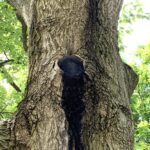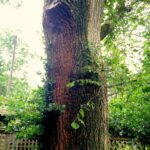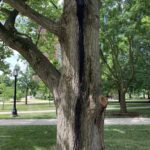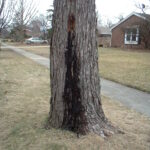Slime flux (also known as wet wood) is a dark, foul-smelling and unsightly seepage of sap from tree trunks (fig. 1). The disease is not usually a serious problem but the appearance can be alarming. Slime flux is caused by common surface-inhabiting bacteria or yeast fungi that enter the trunk through wounds associated with improper pruning, stem breakage, injections, cracks from freeze injury or weak limb crotches. The bacteria and yeast may live on sap nutrients within injured trees for many years without any outward evidence.
Symptoms
The main symptom is the appearance of the dark sap oozing on the trunk exterior which happens when gasses produced by growth of the bacteria and yeast cause the internal pressure of the sap to become high enough to force the sap out through cracks in the bark. The dark streaks usually turn light gray or white upon drying. Oozing sap may be frothy and white at the point of exit. Airborne bacteria, yeasts, and fungi often colonize the wet oozing material, which ferments and releases a foul odor. Slime flux may delay wound healing (callus formation).
Slime flux is extremely common on mature elms (fig 2), oak (fig 3) and mulberry; and is seen less frequently on maples (fig 4), paper birch, sycamore, and walnut.
- Figure 2. American Elm
- Figure 3. White Oak
- Figure 4. Silver Maple
Prevention
There is no control or treatment for slime flux. Inserting a drain tube into the tree to relieve pressure and drain infected sap was once an accepted treatment, but is no longer recommended and may do more harm than good. Boring holes in affected trees causes internal spread of the bacteria within the tree and may allow entry of wood decay fungi.
To reduce the chances of susceptible trees developing wet wood avoid unnecessary wounding of the trunk and branches. Proper pruning techniques, HO-4-W, will allow branches to heal more rapidly. Make sure susceptible trees receive good general care; including irrigation when needed and mulch to conserve moisture and keep mowers away from the trunk. Avoid excess traffic in tree root zone to prevent soil compaction and root injury.
The first and most important step for managing a tree disease is to accurately diagnose the problem. The best approach to diagnosis of tree problems is to start by submitting photos of the tree via the digital upload tool on the PPDL website https://ag.purdue.edu/btny/ppdl/Pages/digitalimages.aspx . In the case of slime flux it is impractical to collect the type of physical sample needed for confirmation so photos are the best alternative.
References
Sinclair, W. A. and H. H. Lyon. 2005. Diseases of trees and shrubs. Cornell University Press, Ithaca, NY. 660 pp.
Stipes, R. J. and Campana, R. J. (eds.) 1981. Compendium of Elm Diseases. APS Press, St. Paul, MN.



